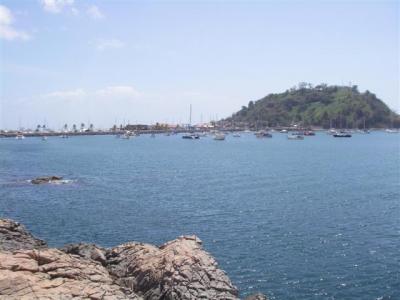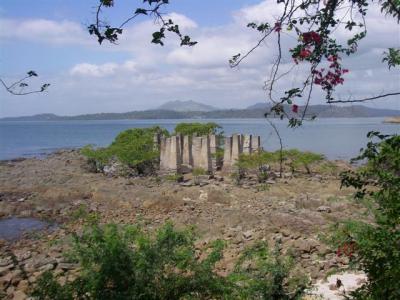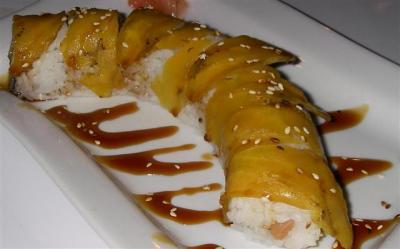We decided to go to the Smithsonian aquarium this morning. For some reason, we were under the impression it is on Flamingo Island. We walked all the way to the cruise ship terminal before we asked where the museum was and found out we were on the wrong island. The nice gentleman helping us told us the aquarium was far away and that we needed to take a taxi. We hopped in a nearby taxi and were very surprised when we were delivered back at the little shopping center by the dinghy dock. We had noticed the land on the other side of the shopping center is fenced in, but we hadn’t thought anything of it. It turns out the fence is around the aquarium. Oops! Oh well, we needed the exercise.
The entrance fee was only $2.00 each. The grounds take up the vast majority of Culebra Island. The aquarium is small, but the facility is a lot more than just an aquarium. There is a walking trail around the grounds with signs telling about the different species that live there, both flora and fauna. It is a scenic walk with a few small beaches and rocky shoreline in between them. The first shot is a view of the anchorage and Flamingo Island. To the left you can just barely see the Bennigan’s shopping center. The second shot is on the other side of the island.


The land on the Pacific side of Panama is considered a dry tropical forest, quite different from the rainforest on the Atlantic side. Plant life on the shore include the Jobo tree, which produces a fruit that feeds many species, including monkeys, deer, coatis, iguanas, humans and many more. The corotu tree one of the biggest in the dry forest and is a versatile plant. The corotu tree can suck as much as 125 gallons (500 liters) of water a day up through its roots. It releases the water through its leaves as a vapor. The tree’s cooked seeds are edible and the bark used for making soap, medicine and tannin. The hylocereus cactus lives in the branches of trees. The cactus blooms at night and is pollinated by moths and bats. Here is a picture of it. We think the cactus looks like hair and the tree looks like it needs a good haircut!

Of course, one of the most important plants for Panama’s ecosystem are mangroves. While mangroves exist happily on the Caribbean side, the mangroves seem to really like big tide swings and flourish on the Pacific side, as do the hundreds of different species that like to live in mangrove swamps, such as fish, birds, shellfish, etc. Something we hadn’t realized is that mangroves have a natural salt filtration system. We thought they were simply able to absorb salt water, but in reality, they turn saltwater into fresh water before they absorb it. Very interesting.
In addition to the animals mentioned above, the dry tropical forests are also home to two toed sloths. Sloths are often compared to Koalas because they live in trees, eat leaves, are hard to spot in the wild, sleep a lot, don’t move much, and move incredibly slowly when they do move. However, they are a completely different genealogical species from Koalas. Termites also reside in the forests. We found out that within a nest there are two types of termites — dark headed soldiers that defend the colonies and white headed laborers.
Creatures that live along the shore include tube worms, isopods and crabs. Whimbrels and Willets are two of the bird species that feed on these little sand creatures. In the summer they go to the Artic to breed and head back down to Panama for the winter. Wow, that is a long way for these little birds to travel! Brown pelicans are also abundant here. We were surprised to find out they only nest in the dry forests of the pacific coast of Panama. Wow. Yellow crowned night herons are another commonly found bird.
The signs on the walking trail also give great information on Panama’s ecosystem, including the effects of tide swings, upwellings and El Nino. El Nino years have a serious negative impact on the Panamanian ecosystem. It disrupts the upwellings when nutrients are brought up from the bottom of the ocean which adversely affects plankton’s ability to produce. Of course, that affects everything else up the food chain ladder.
Another few signs told of the history of Culebra and the surrounding islands. Since the shoreline around Casco Viejo is too shallow for ships to approach, back in the old days ships used to anchor off these islands and row small dingies in to shore. In 1908, the Canal Zone built a quarantine station for people suffering from yellow fever. In 1914, with yellow fever basically eradicated, it was demolished. The pilings from the buildings still remain.

The causeway was built in 1913 from material excavated from the canal. In addition to being a road, it is a breakwater and helps reduce siltation.
We enjoyed our walk around the grounds. There are some really pretty orchids in bloom.
We also saw some gorgeous red and black birds flying around, but we have no idea what they are called. There was no sign for them. We were hoping to spot a sloth, but we didn’t see one. Honestly, we didn’t look very hard.
The aquarium is in a surprisingly small building. It holds a series of fish tanks about the size you would see in a house. Some of the tanks featured species from Panama’s Caribbean side, the rest had species from the Pacific side. They are so different from one another! Each tank had a few species of fish, coral and so forth. We actually didn’t find the aquarium displays to be particularly interesting, but maybe that is because we have seen so many of these same species in the wild already.
A patio area just outside the aquarium building houses three small pools where you are allowed to touch the creatures inside. One pool features a sting ray, manta ray and some varieties of starfish. Another pool has some assorted fish. The last one has sea turtles, but sad for us, the turtle pool was being resurfaced, so the turtles were not in there today. Near the pool is a big display on sea turtles. It is believed in Colombus’s day there were 30 million sea turtles. Now they are endangered. Some species of sea turtles migrate hundreds, even thousands, of miles between their feeding grounds and nesting beaches.
While not big or impressive, we think the aquarium center is informative, interesting, and that the information is easy to comprehend. Definitely a good place to take kids.
After we left the aquarium, we walked to Bennigan’s for lunch. On the way, we saw what looked like a giant guinea pig crossing the road. We figured it had to be a capybara. The locals were telling us about them. Capybaras are the largest rodent in the world, with a length of 4.3 feet (130 cm) and weighing as much as 140 lbs. (65k). It is related to the guinea pig and chinchillas. They eat grass, fruit and tree bark. The locals told us that capybaras are popular pets and are kept much the same way that dogs are. They are socials and like human interaction, and like dogs, bark at potential predators.
Anyway, we aren’t Bennigan’s fans, but Bennigan’s offers free wifi and we needed to access the internet. We had planned to go to a wildlife preserve in the city after lunch, but it involved extensive walking up hills. We decided we had done enough walking and went back to the boat to do chores and get ready to go to sea again.
One the way back, we stopped to chat with another boat in the anchorage that is also from San Diego. They told us that another boat dragged today and almost hit them. They said that there are at least 2 boats a week dragging in this anchorage. Scary.
Back on board Kosmos, we did clean all the sea strainers, but we didn’t do much else. The rocking makes us so lethargic. We ventured back out again for dinner, finally braving being out after dark. We went to a sushi restaurant on island number 2. We tried a roll that had a local fish, smoked salmon, cream cheese, and avocado inside, topped with ripe cooked plantains and a sweet sauce. The plantain was definitely an unusual taste for sushi, but the flavor isn’t very strong and meshed well with the other ingredients. We thought it was really good.

On the way back to Kosmos, we were amazed by the amount of bioluminescence in the water. Usually, if the bioluminescence is active, the water will light up a little bit around the bow, but tonight the water all the way around the dinghy was brightly illuminated. It was really pretty to see.

When you say Bennigans you mean the restaurant that used to be (maybe still is) off the 8 in the mission valley mall parking lot? The chain?
If so, then the only good thing about it is they have pear cider on Tap.